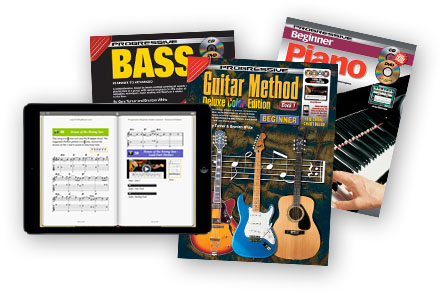<< First < Previous | Intro 1 2 3 4 5 | Next > Last >>
Back to Table of Contents
Progressive Beginner Ukulele – Enhanced Edition provides an easy and enjoyable introduction to the world of ukulele playing. No previous knowledge of music or ukulele playing is necessary.
Through the course of the book, you will learn how to play all the essential chords in both open position and movable forms, along with right hand strumming techniques and rhythms that are used in a wide variety of musical styles. All examples sound great and are fun to play. By the end of the book you will be able to play hundreds of songs and be well on your way to being an excellent ukulele player.
To develop good timing habits right from the start, it is recommended that you use a metronome or drum machine with all the examples in the book until you can play them easily from memory.
The best and fastest way to learn is to use this book in conjunction with:
- Buying sheet music of your favorite recording artists and learning to play their songs. By learning songs, you will begin to build a repertoire and always have something to play in jam sessions.
- Practicing and playing with other musicians as often as possible.
- Learning by listening to your favorite recordings. Start building a collection of albums of players you admire or wish to emulate. Try playing along with one of them for a short time each day. Most of the great ukulele players have learned a lot of their music this way.
In the early stages it is helpful to have the guidance of an experienced teacher. This will also help you keep to a schedule and obtain weekly goals.
Using The Enhanced Features
This enhanced eBook contains video and audio recordings for all exercises. The book explains where to put your fingers and what techniques to use, while the video and audio lets you see and hear how each example should look and sound when played correctly.
Practice the examples on your own, playing slowly at first. Then try playing to a metronome set to a slow tempo, until you can play the example evenly and without stopping. Gradually increase the tempo as you become more confident and then you can try playing along with the recordings.
To play along with the video and audio your instrument must be in tune with it (see Tuning).
A purple bar with a play icon and an exercise number indicates a recorded example like this:
Each enhanced exercise includes:
Video
Watch a close up of the example being played by a professional teacher so you can check your technique and hear how the example should sound when played correctly.
Click the play icon (triangle) to start the video playing and then click the full screen icon (2 arrows) to expand the video to fill the screen. A band is performing with the teacher so you can hear how the exercise sounds when played together with other instruments. Drag the slider to watch different parts of the exercise again. Please note that the video is best viewed in landscape orientation.
Solo Track
Listen to the example played by itself so you can focus on the part you are learning. Click the play icon (triangle) to start the audio playing. Drag the slider to hear different parts of the exercise again.
Backing Track
When you are comfortable playing the exercise, use this audio to practice playing along with the backing band by yourself. Click the play icon (triangle) to start the audio playing. Drag the slider to hear different parts of the exercise again.
Full Page Score
For longer examples, the music score for the exercise is available as a single image for easy viewing. Double-tap the image to open it full screen and then use your fingers to swipe up and down or zoom in and out. Please note that you can have the audio playing and the full page score open at the same time.
Approach To Practice
From the beginning you should set yourself a goal. Many people learn the ukulele because of a desire to play like their favorite artist (e.g., Tiny Tim or Israel Kamakawiwo’ole), or to play a certain style of music (e.g., Hawaiian songs, Swing, etc.). Motivations such as these will help you to persevere through the more difficult sections of work. As you develop it will be important to adjust and update your goals.
It is important to have a correct approach to practice. You will benefit more from several short practices (e.g., 15-30 minutes per day) than one or two long sessions per week. This is especially so in the early stages, because of the basic nature of the material being studied. In a practice session you should divide your time evenly between the study of new material and the revision of past work. It is a common mistake for semi-advanced students to practice only the pieces they can already play well. Although this is more enjoyable, it is not a very satisfactory method of practice. You should also try to correct mistakes and experiment with new ideas.
Tuning Your Ukulele
Before you commence each lesson or practice session you will need to tune your ukulele. If your ukulele is out of tune everything you play will sound incorrect even though you are holding the correct notes. For a complete description of how to tune your ukulele, see the methods shown in the section on tuning.
Electronic Tuner
The easiest and most accurate way to tune your ukulele is by using an electronic tuner. An electronic tuner allows you to tune each string individually to the tuner, by indicating whether the notes are sharp (too high) or flat (too low). The tuner will have an inbuilt microphone. There are several types of electronic tuners but most are relatively inexpensive and simple to operate.
Tuning using other methods is difficult for beginning musicians and it takes many months to master, so we recommend you purchase an electronic tuner, particularly if you do not have a teacher or a friend who can tune it for you. Also if your ukulele is way out of tune you can always take it to your local music store so they can tune it for you. Once a ukulele has been tuned correctly it should only need minor adjustments before each practice session.
How To Hold The Ukulele
The main aim is to be comfortable and have easy access to the ukulele fretboard. A music stand will also be helpful.
The Rudiments Of Music
The musical alphabet consists of 7 letters: A B C D E F G
This clef indicates the position of the note G. It is an old fashioned method of writing the letter G, with the center of the clef being written on the second staff line.
The other lines and spaces on the staff are named as such:
When the note head is below the middle staff line the stem points upward and when the head is above the middle line the stem points downward. A note placed on the middle line (B) can have its stem pointing either up or down.
Time Signatures
At the beginning of each piece of music, after the treble clef, is the time signature.
The time signature indicates the number of beats per bar (the top number) and the type of note receiving one beat (the bottom number). For example:
The next most common time signature is Three Four Time written  .
.
Note Values
The following table shows the most common notes used in music and their respective time values (i.e., length of time held). For each note value there is an equivalent rest, which indicates a period of silence.
If a dot is placed after a note it increases the value of that note by half, for example:
| Dotted half note |  |
(2 + 1) = 3 counts |
| Dotted quarter note |  |
(1 + ½) = 1½ counts |
| Dotted whole note |  |
(4 + 2) = 6 counts |
The timing of basic note values, rhythms and rests can also be illustrated in the following table.
Chord Diagrams
Chords are learned with the help of a chord diagram. This will show you exactly where to place your left hand fingers in order to play a particular chord. A chord diagram is a grid of horizontal and vertical lines representing the strings and frets of the ukulele as shown.
The dots show you where to place your left hand fingers. The number tells you which finger to place on the string just before the fret. If there is no dot on a string, you play it as an open (not fretted) string.
A small bar connecting two or more dots indicates that they are held down by the same finger. This is called barring.
Rhythm Symbols
<< First < Previous | Intro 1 2 3 4 5 | Next > Last >>
Back to Table of Contents


























































